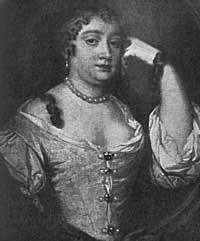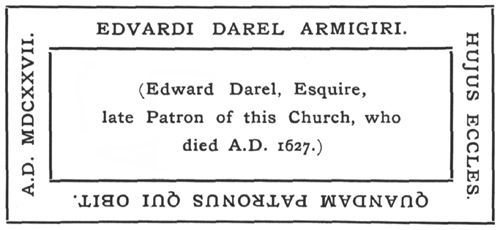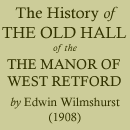< Previous | Contents | Next >
The Lady Anne Hyde.

THE LADY ANNE HYDE, DUCHESS OF YORK. Mother of Queen Mary II. and Queen Anne; and Grand-daughter of Anne Denman, of the Olde Hall, West Retford.
Among the celebrated Beauties of the Court of the Merry Monarch, immortalized by the brush of Sir Peter Lely, the Lady Anne Hyde, daughter of the Lord Chancellor, and Maid of Honour to the Princess Royal, was conspicuous for the redundancy of her charms, and for the voluptuous embonpiont so dear to the great masters, Rubens, Titian, Lely, and the artists of their school. Her well-known Portrait by Sir Peter Lely, is in the British National Portrait Gallery in London.
The King's only Brother, the Duke of York, was smitten, and even at that gay and dissolute court, only honourable marriage could be thought of by the granddaughter of Anne Denman, of West Retford. A legal, but clandestine marriage was solemnized, but when prospect of a family became evident, and as there was no legitimate issue to the King, it became necessary that the marriage should be avowed, and the Duke of York sought an interview with his brother. The King listened and replied— "Jamie, as you have brewed (alluding to the Duchesses brewer grandfather), so must you drink," and Lady Anne Hyde was publicly proclaimed Duchess of York.
It is most probable that the Lord Chancellor at this time, assigned to his daughter, as dowry, his noble mansion at Twickenham, as it then became the country residence of the Duke and Duchess of York, and here was born, later, the Princess Anne; and here the two Princesses, Mary and Anne, spent much of their youth (the Lord Chancellor residing at Cranbourne Lodge, in Windsor Park); and the Twickenham residence has ever since been known as York House. At his decease at Rouen, in 1674-5, aged 67, Lord Clarendon's body was brought, and deposited in the Hyde vault in Westminster Abbey. (Recorded in registers) " The Earl of Clarendon—in the Abbey—born at Dinton, Wilts., 18 Feb., 1608-9—at the East-end of the Chapel of Kings, at the foot of the steps ascending to King Henry VII.'s Chapel." He survived his wife 13 years. The registers record in 1661, her burial in the same vault—"Frances, daughter and sole heiress of Sir Thomas Aylesbury, Bart., by Anne his wife, and second wife of Sir Edward Hyde, first Earl of Clarendon."
Her Mother (Anne Denman) Lady Aylesbury (and 17 others of the Hyde family) was also interred in the Hyde vault. She seems to have secured the regard of her grand-son-in-law, James, Duke of York; and Pepys in his Diary, under date Nov. 13th, 1661, states "The Duke of York was in mourning for his wife's grandmother, which (he adds) was thought a great peace of fondness"—and which grandmother was Anne Denman, of the Old Manor House, West Retford, Notts.—now the Trinity Hospital.
The Earldom of Clarendon was held by direct descendants up to the death of the fourth Earl in 1753, whose only son predeceased him, when all the titles became extinct; but the Clarendon blood continued, for, by his first wife, the first Earl bad a daughter—Anne—who married William, Earl of Essex; and their eldest daughter, Charlotte, on March 1st, 1752, married unto the Hon. T. Villiers, who on May 31st, 1756, received the revived and re-created title of Baron Hyde of Hindon, Wilts.; and on June 8th, 1776, he received a further advance, being created Earl of Clarendon, and the Earldom still exists, and at this date (1908) both the Earl of Clarendon, and Thomas—Baron Denman,—hold office under the present Government.
Queen Mary II. and Queen Anne.
Towards the end of the reign of King Charles II., the Duke of York lost his wife (Lady Anne Hyde), and her two daughters, by the King's influence, were married to Protestant Princes, his policy being to counteract in public opinion, the disfavour with which the nation noticed the increasing Romanist proclivities of the Duke of York, who made a second marriage with the Italian Princess Mary of Modena, who arrived from Italy with a confessor, and retinue of that faith.
The Princess Mary espoused her cousin William, Prince of Orange, the champion and trusted leader of the Continental Protestants, against the power of the French "Eldest Son of the (Roman) Church"—Louis XIV.; and the Princess Anne, in 1683, married Prince George of Denmark, who took up his residence in England.
In 1685, on the accession of their father, as James II., their uncle, Earl of Rochester, was made Lord Treasurer, and the second Earl of Clarendon, Lord Chamberlain ; but as they proved hostile to the King's Romanist proclivities, Lord Rochester was turned out of office the next year, and Lord Clarendon was sent, nominally as Viceroy, to Ireland, but where he was under the military power of the Romanist General Lord Tyrconnel. The events of James II.'s short reign are matters of history: with the desire and consent of the nation, the Prince of Orange landed at Torbay on November 5th, 1688.
The Princess Anne with Lady Churchill, and attended by the Bishop of London, fled to her grandmother's native county, and was received in Nottingham with great respect by the Duke of Dorset, the Governor; and the Notts, gentry formed a special Troop of Honour for her defence. Her husband, Prince George, with the Duke of Ormond, having left the King, and joined the Prince of Orange, who was accompanied by his friend and staunch follower, Bentinck— whose descendents, the Dukes of Portland, are magnates in Nottinghamshire to this day.
The flight of King James II. soon took place, and William and Mary were proclaimed joint Sovereigns; succeeded in due course of time, by Queen Anne, in 1702, both Queens having children who all died in infancy:—with them the dynasty of the Stewart's came to an end, and, with them, also, ended the Denman blood in connection with the Royal Family, and also ended the West Retford branch of that name, which we have traced to her great-grand-daughters Queen Mary and Queen Anne, from Anne Denman, second daughter of Francis Denman, of the Old Hall—now the Trinity Hospital (co-lateral branches of the Denman family being still resident in Retford and neighbourhood).
The Founder.
Leaving now the atmosphere of the English Court, we return to the peaceful, but less romantic history of Barbara, eldest co-heiress, who married Edward Darell. They resided at the Old Hall, West Retford, and also at his Lincolnshire Manor of Horkstowe, until his death in 1627 (in second year of King Charles I.). Torre's York M.S. gives "Edward Barrel, of West Retford, Esquire, to be buried in ye South Quire of the Chuich, February 14th, 1627" (where his grave may be seen to this day—1908).

The following description is from a private, and traditional source:—
He was of medium height, slight built, black pointed beard and hair, rather waxen complexion: shewn in academical gown, red M.A. hood of Oxon, black bands edged with white: at another time in black velvet cloak, and with a gold "chain of office" round neck. He had the misfortune, quite by mistake, to kill a man, and it was his wish and intention to do something in "expiation." His elder son Thomas seems to have had a prospective interest in the West Retford Estate, which was left in the hands of trustees, for it is recorded that, by a secret Deed, he mortgaged to Lady Diana Cranbourne, "lands in the Biggins" value of 45 pounds per annum. A decree of Chancery restored the lands to the trustees, but chargeable with £118 down and £40 per annum for ever to heirs of one Richard Cooke. The trustees let the mortgagees foreclose, and so "The Biggins," in West Retford Parish was alieniated from the Estate. This Thomas, eldest brother, was Secretary to the Council of War, 1645-1648; and Receiver General to the Earl of Salisbury, 1652; and died intestate in London, 1664, unmarried, or no issue. The second son, Bryan, a "merchaunt of York," died unmarried, 1653; and Edward (third) also in 1652; Francis (fourth) died 1659, no issue; Rev. William (fifth), of St. Mary's Hall, Oxon., M.A., and Fellow of All Souls', ejected by Puritans, 1648, Rector of West Retford, 1642, died 1659, unmarried. He seems to have again experienced his persecutor's attentions later, for documents preserved in the library at Lambeth Palace of an "enquiry" in Cromwell's time state, "The parsonage of West Retford, fortie-five pounds per annum. Mr. William Darrwell the present Incumbent, who has the cure of souls there, is a constant preacher, and free from scandal."
Signed by the Commissioners appointed for Notts, (by the "Rump")—EDWARD NEVILE, WM. WIGHTMAN, NATHANIEL HOBSON, JOHN MARTYN, JOHN MASON,
Their Mother, Barbara, died in 1654, when Francis, Rev. William, and John, were yet living. She was not buried with her husband in the "South Quire," but in the Denman vault in the chancel of West Retford Church, and the inscription records (at present legible)—
"Barbara Darel Edwardi Darel Armigiri, uxor prsesen-tibus chara posteris desiderata hie in spem resurectionis requiescit. Obiit iiii. Mart ii., A.D. MDCLIV."
Dame Barbara was a widow 29 years, surviving several of her children. On Feb. 2nd, 7th year of King Charles I., she was living in London; and in the 14th year of same King is described as "then residing in York." A family connection seems to have existed between the Denman and the Sloswicke families, who are described as of North Gate, East Retford.

